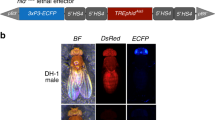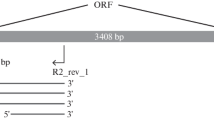Abstract
A reciprocal translocation between chromosome 2 and 3, designated T2, was viable when homozygous in the ROCK strain ofAedes aegypti. It was backcrossed five times with Delhi wild type material. Despite intensive efforts it was not possible to re-isolate it as a homozygote, indicating that a factor in the Delhi background interacted with the translocation and caused recessive lethality. In certain families inbreeding without the production of genetically marked non-translocation homozygotes suggested that a translocation homozygote line had been isolated but, when outcrossed, all the individuals were found to be translocation heterozygotes. It was shown that a balanced lethal system existed which maintained permanent translocation heterozygosity in this line.
Similar content being viewed by others
References
CURTIS, C F, SOUTHERN, D I, PELL, P E and CRAIG CAMERON, T A (1972). Chromosomal translocations inGlossina austeni, Genet. Res. 20, 101–113.
LORIMER, N, HALLINAN, E and RAI, KS (1972). Translocation homozygotes in the yellow fever mosquito,Aedes aegypti. J. Hered. 63, 158–63.
RAI, K S (1967). Manipulation of cytogenetic mechanisms for genetic control of vectors, WHO Scientific group on the ‘Cytogenetics of vectors of Disease of Man’. SC/VG 67. 34, 12pp
RAI, K S, LORIMER, N and HALLINAN, E (1974). The current status of genetic methods for controllingAedes aegypti. In:The Use of Genetics in insect control; Eds. R Pal and M J Whitten. Elsevier/North Holland Chapter 7, 119–132.
ROBINSON, AS and VAN HEEMERT, C (1975). Preliminary radio-biological studies onHylemya antiqua Meigen and data on three radiation induced (0. 5 krad) chromosomal rearrangements. ‘Sterility principle for Insect Control’ 1974. I A E A, Vienna, 375–385.
WAGONER, DE, McDONALD, IC and CHILDRESS, D (1974). The present status of genetic control mechanisms in the housefly.Musca domestica L. In:The Use of genetics in insect control; eds. R Pal and M Whitten, Elsevier, North Holland, Chapter:9. 183–197.
UPPAL, D K, CURTIS, C F and RAI, KS (1974). A double translocation heterozygote inAedes aegypti.J. Com. Dis., 6(2), 98–101.
Author information
Authors and Affiliations
Rights and permissions
About this article
Cite this article
Uppal, D.K., Curtis, C.F. Interference by recessive lethals in the re-isolation of a translocation homozygote inAedes aegypti . J Genet 62, 53–60 (1975). https://doi.org/10.1007/BF02985166
Issue Date:
DOI: https://doi.org/10.1007/BF02985166




